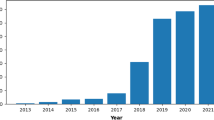Abstract
In early 2018 Bitcoin prices peaked at US$ 20,000 and, almost two years later, we still continue debating if cryptocurrencies can actually become a currency for the everyday life or not. From the economic point of view, and playing in the field of behavioral finance, this paper analyses the relation between Bitcoin price and the search interest on Bitcoin since 2014. We questioned the forecasting ability of Google Bitcoin Trends for the behavior of Bitcoin price by performing linear and nonlinear dependency tests, and exploring performance of ARIMA and Neural Network models enhanced with this social sentiment indicator. Our analyses and models are founded upon a set of statistical properties common to financial returns that we establish for Bitcoin, Ethereum, Ripple and Litecoin.





Similar content being viewed by others
References
Arias M, Arratia A, Xuriguera R (2013) Forecasting with Twitter data. ACM Trans Intelligent Syst Technol (TIST) 5(1):1–24
Brandt P (2016). MSBVAR: Markov-Switching, Bayesian, Vector Autoregression Models. R package version 0.9-3. https://CRAN.R-project.org/package=MSBVAR
Chan S, Chu J, Nadarajah S, Osterrieder J (2017) A statistical analysis of cryptocurrencies. J Risk Financial Manag 10(2):12
Chu J, Nadarajah S, Chan S (2015) Statistical analysis of the exchange rate of Bitcoin. PLoS ONE 10:e0133678
Ciulla F, Mocanu D, Baronchelli A, Gonçalves B, Perra N, Vespignani A (2012) Beating the news using social media: the case study of American Idol. EPJ Data Sci 1(1):8
CoinMarketCap https://coinmarketcap.com/
Constantine W, Percival D (2017). fractal: A Fractal Time Series Modeling and Analysis Package. R package version 2.0-4. https://CRAN.R-project.org/package=fractal
Cont R (2001) Empirical properties of asset returns: stylized facts and statistical issues. Quantitative Finance 1(2):223–236
Fama E (1965) The behavior of stock market prices. J Business 38(1):34–105
Ginsberg J, Mohebbi MH, Patel RS, Brammer L, Smolinski MS, Brilliant L (2009) Detecting influenza epidemics using search engine query data. Nature 457(7232):1012
Granger CWJ (1969) Investigating Causal Relations by Econometric Models and Cross-Spectral Methods. Econometrica 37:424–438
Grcar M, Cherepnalkoski D, Mozetic I, Novak PK (2017) Stance and influence of Twitter users regarding the Brexit referendum. Comput Social Netw 4(1):6
Hencic A, Gourieroux C (2014) Noncausal autoregressive model in application to Bitcoin/USD exchange rate. Econometrics of Risk. Springer, Berlin, pp 17–40
Hyndman RJ, Khandakar Y (2008) Automatic time series forecasting: The forecast package for R. Journal of Statistical Software 26(3)
Kendall M (1953) The analysis of economic time series, part I: prices. J R Stat Society 116:11
Kristoufek L (2015) What are the main drivers of the Bitcoin price? Evidence from wavelet coherence analysis. PLoS ONE 10:e0123923
Kwiatkowski D, Phillips PCB, Schmidt P, Shin Y (1992) Testing the null hypothesis of stationarity against the alternative of a unit root. J Econometrics. 54(1–3):159–178
Lazer D, Kennedy R, King G, Vespignani A (2014) The parable of Google flu: traps in Big Data analysis. Science 343:1203
Lee TH, White H, Granger CWJ (1993) Testing for neglected nonlinearity in time series models. J Econometrics 56:269–290
Mandelbrot B (1963) The variation of certain speculative prices. J Business 36:394–419
Massicotte P, Eddelbuettel D (2019) gtrendsR: Perform and Display Google Trends Queries. R package version 1.4.4. https://CRAN.R-project.org/package=gtrendsR
Nakamoto S (2008) Bitcoin: a peer-to-peer electronic cash system. Bitcoin. https://bitcoin.org/bitcoin.pdf
Nason G (2013) A test for second order stationarity and approximate confidence intervals for localized autocovariances for locally stationary time series. J R Stat Society B 75:879–904
Priestley M. B, Rao T. S (1969) A test for non-stationarity of time-series. J R Stat Society B (Methodological) 31(1):140–149
Sapuric S, Kokkinaki A (2014) Bitcoin is volatile! Isn’t that right? Business Information Systems Workshops. Springer, Lecture Notes in Business Information Processing. Berlin, pp 255–65
Teraesvirta T, Lin CF, Granger CWJ (1993) Power of the neural network linearity test. J Time Series Anal 14:209–220
Trapletti A, Hornik K (2019) tseries: Time Series Analysis and Computational Finance. R package version 0.10-47
Funding
Research supported by Grant TIN2017-89244-R from MINECO (Ministerio de Economía, Industria y Competitividad) and the recognition 2017SGR-856 (MACDA) from AGAUR (Generalitat de Catalunya).
Author information
Authors and Affiliations
Corresponding author
Ethics declarations
Conflicts of interest
The authors declare that they have no conflict of interest.
Additional information
Publisher’s note
Springer Nature remains neutral with regard to jurisdictional claims in published maps and institutional affiliations.
Supplementary Information
Below is the link to the electronic supplementary material.
Rights and permissions
About this article
Cite this article
Arratia, A., López-Barrantes, A.X. Do Google Trends forecast bitcoins? Stylized facts and statistical evidence. J BANK FINANC TECHNOL 5, 45–57 (2021). https://doi.org/10.1007/s42786-021-00027-4
Received:
Accepted:
Published:
Issue Date:
DOI: https://doi.org/10.1007/s42786-021-00027-4






